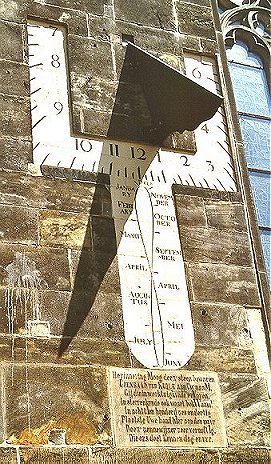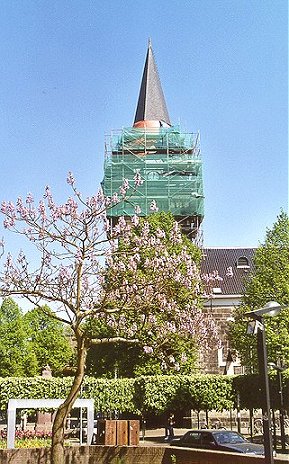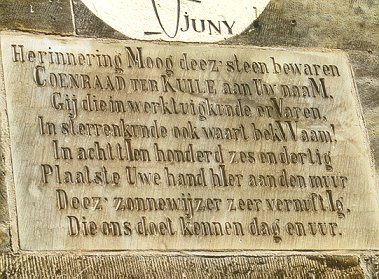

Vertical dials
St. Jacob's Church, Enschede
 |
 |
I knew this dial from pictures, but it appeared surprisingly large when I actually visited it. The church window in the left-hand picture may give you a clue. Or try to find it on the other picture, between the trees. Note that I also scored another wrapped monument here...
The dial is slightly west declining. Most notable is the analemma, which is located below the actual dial face. The shadow of the gnomon tip touches the analemma (at the side of the present month) at local mean noon. This is the oldest public dial still existing in the country which yields mean time.
The analemma lacks a time scale in minutes, so the equation of time cannot be read at an arbitrary moment. Some dials have the analemma twisted around the noon line. When the date is also clearly indicated, like in Noyers, the analemma can be used as a graph for reading the equation of time.
A stone is inserted below the analemma, in which a poem is carved. It is interesting to have a closer look, even when your Dutch is weak:

Don't mind the translation; it says that the dial was designed by Coenraad ter Kuile and was constructed in 1836. The poem is a chronogram; taken together, the bold capitals constitute the year 1918 in Roman numerals: MCMVWIII, when the stone was placed.
Of course the year should be written as MCMXVIII, but the poet probably could not think up an X-word. It was replaced by a double V, or W. Shouldn't it have been written MCMWVIII, then? Fortunately, Roman numerals are not too imperative...
Location: 52.2° N, 6.9° E
We visited Enschede less than a week before the terrible fireworks disaster which hit the city on May 13, 2000. It is sad to recall that Enschede was hurt earlier: a big fire reduced the city to ashes in 1862. That is why Enschede has almost no historical buildings.
Nearby sundials at my website: